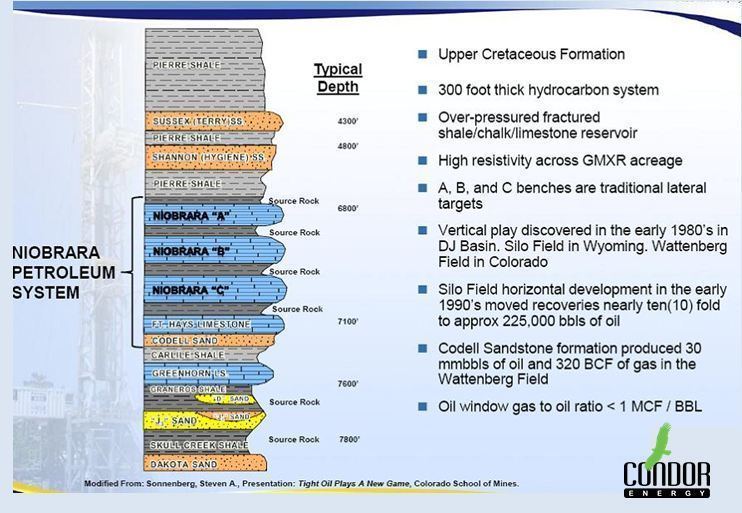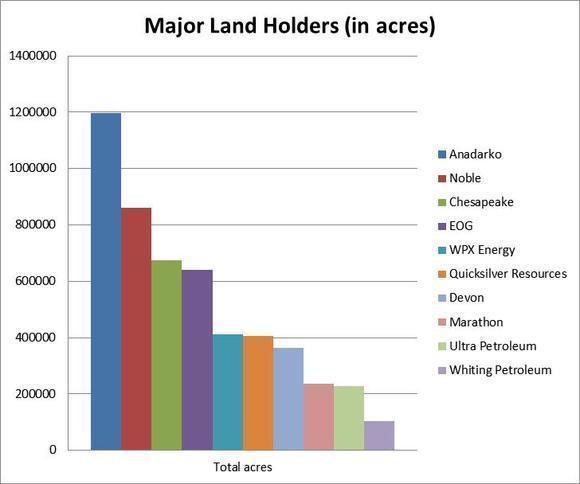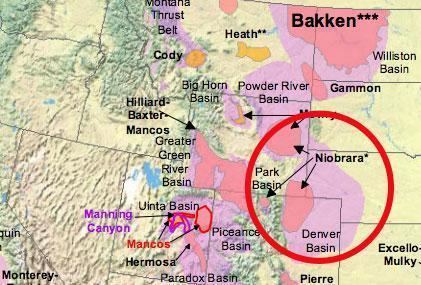Type Geological formation Region North America Primary Chalk | Other Shale Country USA | |
 | ||
Sub-units Smoky Hill Chalk MemberFort Hays Limestone Member | ||
Clams in kansas paleontology at the niobrara formation david rives
The Niobrara Formation /ˌnaɪ.əˈbrærə/, also called the Niobrara Chalk, is a geologic formation in North America that was deposited between 87 and 82 million years ago during the Coniacian, Santonian, and Campanian stages of the Late Cretaceous. It is composed of two structural units, the Smoky Hill Chalk Member overlying the Fort Hays Limestone Member. The chalk formed from the accumulation of coccoliths from microorganisms living in what was once the Western Interior Seaway, an inland sea that divided the continent of North America during much of the Cretaceous. It underlies much of the Great Plains of the US and Canada. Evidence of vertebrate life is common throughout the formation and includes specimens of plesiosaurs, mosasaurs, and pterosaurs as well as several primitive aquatic birds. The type locality for the Niobrara Chalk is Knox County in northeastern Nebraska.
Contents
- Clams in kansas paleontology at the niobrara formation david rives
- History of exploration
- Stratigraphy
- Flora and fauna
- Invertebrate life
- Fish
- Turtles
- Plesiosaurs
- Mosasaurs
- Pterosaurs
- Nonavian dinosaurs
- Birds
- References
History of exploration

The Niobrara Chalk was first studied during an expedition led by Othniel Charles Marsh of Yale University in 1870. This and following expeditions to the area in 1871 and 1872 yielded the first of many fossil vertebrate remains commonly attributed with the formation. Excavations continued through the following years up to 1879 under the direction of professional fossil collectors such as B. F. Mudge and S. W. Williston appointed by Marsh.

The Niobrara Chalk has been continuously explored ever since, with specimens being found by H. T. Martin of the University of Kansas and George F. Sternberg, the son of the famous fossil collector Charles H. Sternberg. Much of the best material from the formation is on display at the Sternberg Museum of Natural History in Hays, Kansas.
Stratigraphy

The Smoky Hill Member of the Niobrara Chalk contains the majority of the fossils found in the formation, and is subdivided into 23 marker beds. Most vertebrates are present from the upper half of the member. Most of the vertebrate remains were collected and described before the stratigraphy of the Niobrara Chalk was fully understood. Specimens were described as being from layers referred to as being either of gray-blue shale or yellow chalk. This dichotomy is not indicative of different stratigraphic units as was previously thought, but rather is seen as a weathering phenomenon that can be found at varying points in the same outcrop.
The Niobrara Formation is overlain by the marine Pierre Shale.
Flora and fauna

During the time of the deposition of the Niobrara Chalk, much life inhabited the seas of the Western Interior Seaway. By this time in the Late Cretaceous many new lifeforms appeared such as mosasaurs, which were to be some of the last of the aquatic lifeforms to evolve before the end of the Mesozoic. Life of the Niobrara Chalk is comparable to that of the Dakota Formation, although the Dakota Formation, which was deposited during the Cenomanian, predates the chalk by about 10 million years.
Invertebrate life

Clams, oysters, crinoids, ammonites, and squid are all common in the Niobrara Chalk and must have comprised the majority of life at the time. Evidence of sponges, annelid worms, and crustaceans are less common and are usually found as trace fossils.
Fish
Fish are by far the most common fossils found from the formation, with remains of pehistoric sharks, ray-finned fishes, and lobe-finned fishes in abundance. As well as smaller fish, many large predatory fish were present in the seas at that time, most notably Xiphactinus. Several fish were of close relation to modern day fish including primitive coelacanths, slimeheads, lancetfish, gars, and salmonids.
Turtles
Sea turtles have been found from the Niobrara Chalk that reached large sizes. The biggest, Archelon, attained a length of up to 4m, and was about 4.87m from flipper to flipper, considerably larger than its distant relative, the leatherback sea turtle, which is the largest of the sea turtles alive today. The sea turtles most likely fed on ammonites, squid, and other cephalopods.
Plesiosaurs
Plesiosaurs are present from two different families within Plesiosauroidea in the Niobrara Chalk: the Polycotylidae, or short-necked plesiosaurs, and the Elasmosauridae, or long-necked plesiosaurs. Polycotylids superficially resemble pliosaurs, which are not present within the formation, but are unrelated. They were fast swimmers, unlike the Elasmosaurs that used their long necks to catch fish. Plesiosaurs are rare in the formation and were therefore likely uncommon in the seas at the time. Specimens become much more numerous in the Pierre Shale situated above the chalk.
Mosasaurs
Mosasaurs are the most common marine reptiles in the Niobrara Chalk and the most successful ones in the sea at the time. Four different genera representing the four different subfamilies of Mosasauridae: the Tylosaurinae, Plioplatecarpinae, Mosasaurinae, and Halisaurinae, were present in Niobrara. They were the dominant carnivorous marine reptiles and ate cephalopods, fish, turtles, pterosaurs, birds, and even plesiosaurs. There is evidence of them consuming other smaller mosasaurs. Despite this, mosasaurs often fell prey to some of the large sharks at the time, such as Cretoxyrhina.
The presence of young mosasaurs in the formation suggests that mosasaurs were viviparous and gave birth hundreds of miles out to sea, as Niobrara was in the middle of the Western Interior Seaway at the time. Juveniles would have been vulnerable to predation by the many large mid-ocean predators, so it is likely that mosasaurs lived in groups rather than solitarily. Also, viviparous species tend to have much fewer offspring than egg-laying ones, so if there were few young that were born, they were most likely to have sought protection within groups in order to reach adulthood and thereby maintain the population of mosasaurs.
Pterosaurs
Between two and four genera of pterosaurs are present in the formation, depending on the taxonomy. All but Nyctosaurus belong to the Pteranodontidae family of the suborder Pterodactyloidea, though even Nyctosaurus has occasionally been included in that family, and is at least a close relative of the pteranodonts. All are large pterosaurs with elongated cranial crests in male specimens. The pterosaurs of Niobrara probably spent most of their time at sea and rarely went on land. Nyctosaurus lacked all but the fourth phalanx of the hand, which is the extended finger that supports the wing membrane, meaning that quadrupedal locomotion on the ground would have been limited compared to other pterosaurs that were proficient at walking based on fossilized trackways that show both limbs in use on the ground.
Nonavian dinosaurs
Nonavian dinosaurs have been found in the Niobrara Chalk despite it being located hundreds of miles out to sea at the time. The most reasonable theory is that the carcasses drifted out to sea. It is unlikely that the bodies were carried out by outgoing tides along the shorelines where they died, but rather it is more probable that the dinosaurs were carried offshore by floodwaters during a storm. In the shallow waters the bodies would have begun to decompose and bacteria within the carcass would have produced gasses that would have accumulated in the gut, thereby making the body buoyant. Next, the prevailing winds and currents would have carried it out to sea, where it would eventually settle to the bottom and be buried in sediment.
A few caudal vertebrae from a hadrosaur have been found with bite marks and have been eroded, suggesting at one point they were digested. A single tooth belonging to Squalicorax was found in situ under the vertebrae. This suggested the shark consumed the posterior end of the tail of a floating hadrosaur carcass and had partially digested it before fossilization. Most dinosaurs in the chalk were nodosaurs. No remains of cerapods nor non-avian theropods were found, both being common dinosaurs present at the time.
Birds
Three genera of birds are present in the formation, although rare. They were outside the clade containing modern birds, and they still retained teeth. Baptornis and Hesperornis were large flightless aquatic birds suited for diving. Ichthyornis was a seabird that resembled the gulls and petrels of today. Both probably preyed on small fish and were preyed upon by sharks, large bony fish such as Xiphactinus, and mosasaurs.
